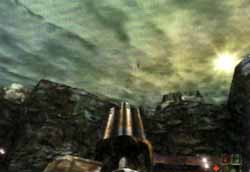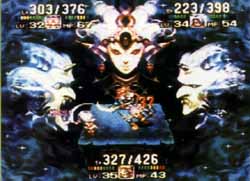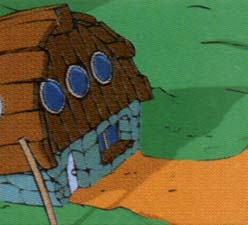Following the generalization of 3D graphics (due to the ever increasing power of PCs and the dawn of 32 bits videogame systems in 1994), architecture has become a fundamental component in virtual worlds -specifically in Quake-likes and 3rd person view adventure games. Still, developers rarely see beyond its functional aspect. A pity if you ask me : ambitious games like Unreal (PC, 98), The Wheel of Time (PC, 99), Perfect Dark (N64, 00), or Zelda 64 (N64, 98), based on thoughtfully designed settings, prove that architecture can contribute to deepening the value, meaning and aesthetic of interactive entertainment.
ON THE SPECIFICS OF VIRTUAL ARCHITECTURE
Architecture student Arnaud insists on the artistic liberties granted to game designers : "In a game you're no longer a slave to the laws of physics. Forget gravity, constraints of form, weight, and size… As for topography, one is able to create the ideal map : you're doing nature's work ! You can do whatever you want, but developers tend to reproduce reality. It's a bit sad". Indeed, rather than letting imagination go, many game designers rely on the proven fabric of the concrete world.
 Unreal
Unreal
The wish to depict reality as faithfully as possible has been an irrepressible trend in every young art form, and videogames are no exception to the rule. Fortunately, some games disregard this quest for realism. Thus, the forest castle in Zelda 64 features a striking corridor, which progressively bends into a spiral as the player goes further. Or this other room, also featured in Miyamoto's peculiar masterpiece, where a seemingly infinite vastness unfolds as Link fights a silvery doppelganger in the water castle. This magnificently refined environment, whose only features lie in a solitary tree and a doorframe, is covered with a thin layer of water stretching endlessly towards the horizon. Unreal is also filled with sublime landscapes : levitating worlds, gigantic castles, valleys, waterfalls and rivers of unbelievable grandeur and eerie tones… Explorations in virtual architecture, when led by inspired artists, prove to move in quantum leaps towards an experience so involving that it breaks through previous attempts at suspending our disbelief.
LIGHT, ARCHITECTURE AND ATMOSPHERE
Light seems to be some ugly duckling in contemporary virtual design : real-time lighting reflection, transparency, contre-jours are underused… And yet, these effects prove to be vital in bringing locations into character.
The use of light to strengthen settings and characters, and color as a vector for emotion, are the fundamental teachings given to us by German expressionism and impressionist painting, respectively. Many developers could learn from that. "Light is essential to set the mood, though few games really use it. Settings and textures improve that's a fact, but light doesn't seem to", explains Arnaud.
In order to be convincing a virtual world has to feature familiar referents. Light is one of them, and the notions of time (night and day, seasons…) and climatic conditions are absolutely primordial, for it is through change that a world comes alive. RPG designers were the first to understand it : legendary titles such as Dragon Quest V (SFC, 91), Ogre Battle (SFC, 94), Seiken Densetsu 3 (SFC, 95) or Tengaï Makyo Zero (SFC, 96) flowed with the course of the sun. Zelda 64, a landmark in compelling atmospheres, was the first 3D game to include this old principle : the lighting variations brought by the changing position of the sun, the rain and sandstorms gifted the world of Hyrule with a soul, an immediate emotional impact.
 Seiken Densetsu 3
Seiken Densetsu 3
According to famous architect Jean Nouvel, "what one wants to build, one must picture at night-time, at dawn, lost in an engulfing mist or under the rain… not only under a 45 degrees light source as they do in architecture schools. I, more than another, like to consider what is subject to the mayfly, to time, to our views changing with moments. Architecture is of inert matter, but animates under these exterior conditions, under the human eye" (in L'Express, october 1993). When Nouvel speaks of 'the mayfly', he hints at the continual flow of time and life's unforeseeable aspect. Virtual worlds can produce such transient beauty. Here again, Zelda 64 is exemplary : in its exteriors, the conjugated lighting and design can be astonishing. Hylia Lake seen at dawn, from the roof of the alchemist's house, is bathed in a halftone light, which casts a misty veil on the set. Too few games nowadays are able to propose such aesthetic wonders, but future might see their proliferation (we can trust Square, Nintendo, Sega, Konami and Capcom on this one).
TO BRING CLARITY, MEANING AND DENSITY TO VIRTUAL WORLDS
After all, the primary role of architecture in video gaming goes beyond mere esthetic concerns. According to Arnaud, "architecture is the invisible framework which gifts the crafted world with harmony. And once an environment is brilliantly designed, it is able to lead the player without his realizing it". By underlining dangerous places, traps, interactive elements… a well-crafted architecture helps the player understand the fabric of the virtual place he's evolving into.
Fun is subjugated to the quality of level design. The Carrington Villa in Perfect Dark, with its nearby cave, five entrances and levels, snipers posted on the roof and courtyards, is a very dense and sophisticated gamespace whose different areas can be reached via a variety of routes. By preventing linearity in 3D environments, an elaborated architecture improves replay value and interest. Some designers even made this their motto. Warren Spector (father of the mythical Deus Ex, PC, 2000) puts his foot down : "Maps in a 3D game must feature massive interconnectivity. Tunnels that go direct from Point A to Point B are bad ; loops (horizontal or vertical) and areas with multiple entrances and exit points are good" (from "Postmortem : Ion Storm's Deus EX" in Gamasutra.com).
Architecture's role doesn't stop here. According to Arnaud, it can even "merge each element of the game and create a story". The Digital Koboyz, a famous team of French Architects from Lille, were actively involved into developing Banja, an award winning online videogame by Chman.com. Frank, member of the Digital Koboyz tells us the story : "In the beginning, Chman gave us only a few scattered elements, moods and a state-of-mind. We had the design for Banja and Zelia, the two main characters, the idea of a cute, ecological and pacific world, and various ideas for locations : an old village, a meeting totem, a subterranean city…".
"In the first place, we worked on the island's form and aspect by looking for textures based on a real croissant (NDT: French pastry) ! (Laughs) Then the idea of an evolving world came to mind and we opted for an I-shaped island, @ style. Then we wrote the beginning of the storyline, the genesis : a boat crashes on a reef by the island. Passengers are forced to organize the Robinson Crusoe way. They use wood from the raft to build housing, and urbanizing develops".
Banja's Island inhabitants build housing with wood from the beached raft…
"From this point we conceived other parts of the island : the fisherman's village, the volcano, the lost island… Finally, we came up with a dummy for modeling the island. By this time, we already had many sketches for vegetation, towns… As a final touch, Tony Derbomez, Art Director for Banja, drew from these preliminary works the final form for Banja's Island. He gave the project coherence by discarding certain ideas and adding others".

…then, as architecture develops, they use concrete. A nice attempt at coherently binding scenario and architecture.
This quest for bringing coherence and a solid background to virtual settings without its being too visible for the player is what makes Banja's island something pure and limpid. Beyond the shadow of a doubt, the questions raised by architecture in videogaming are bound to grow more important as virtual universes become increasingly vast and complex.
Article
by Pierre Gaultier (march 2001). English translation by Tristan Ducluzeau.
Special thanks to Arnaud and Frank.
You
want to react to this article ? Contact
us : we really care about your criticisms, your contributions and
your thoughts ! Don't forget to specify the name of the article in your
mail.
